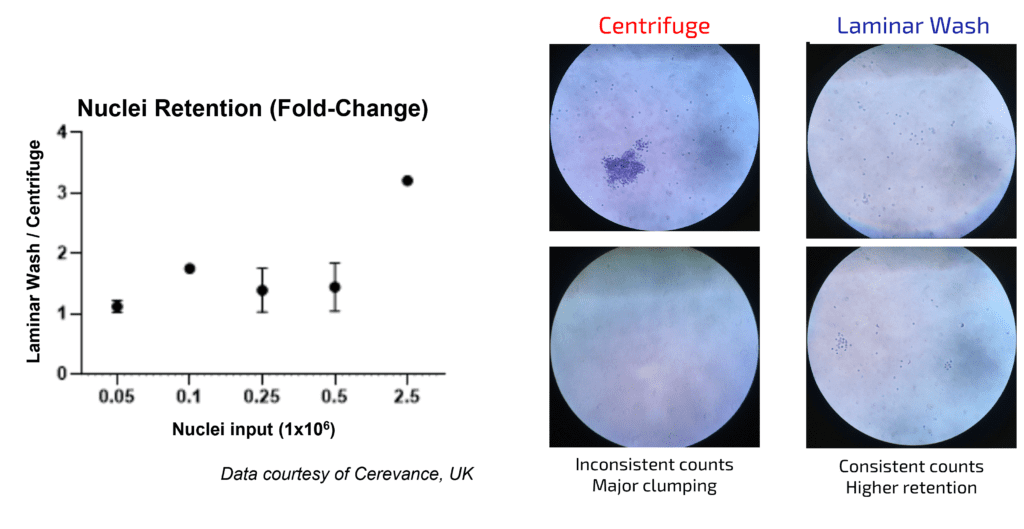即将举行的网络研讨会:实现无需离心的流式细胞术样品制备工作流程的标准化
Laminar Wash™ benefits of automation and gentle cell-based sample preparation can also be extended to nuclei
Analytical methods on individual cells provide an enormous amount of useful information. But not all tissue types lend themselves to preparing single cell suspensions necessary for flow cytometry or single-cell ‘omics analysis. Homogenization and dissociation of interconnected tissues such as neurons typically results in poor yields of intact cells. Fortunately, cell nuclei can be readily isolated from their cellular chateaus and retain sufficient mRNA for FACS sorted/single-cell transcriptomics. Thus, nuclei can act as cellular surrogates for next-generation characterization in tissue types recalcitrant to isolation.
Unlocking nuclei
While procedures for isolating nuclei from cells have improved recently, these methods typically rely on several centrifugation steps, such as passing through high-density sucrose or glycerol. The 10X Genomics Nuclei Isolation protocol for single-cell RNA sequencing recommends users to “maximize input cell viability and minimize cell and nuclei handling time,” which is excellent advice but clashes with centrifuge-based protocols. Furthermore, different tissue types often necessitate additional optimization of preparation parameters, limiting utility in high throughput and scarce sample applications.
Automating the washing steps with Laminar Wash technology offers researchers a solution to the turmoil of nuclei isolation and sample prep. Gentle laminar flow-based washing often results in superior debris removal and nuclei retention, compared to centrifuge-based methods. Miniaturization and running up to 8 or 96 washes in parallel can also cut down on reagent use and extend sample availability for optimization and validation.
Clinical stage neuroscience therapeutics company Cerevance relies heavily on isolated nuclei for target identification. Keenly aware that druggable proteins underlying brain disease can vary not only from region to region, but also between cells, Cerevance employs NETSseq (Nuclear Enriched Transcript Sort sequencing) on postmortem derived tissue. The method encompasses specific selection of disease-relevant cell types, isolating and sorting their nuclei, and sequencing their transcripts, providing a comprehensive picture of neurological pathophysiology.
Addressing challenges at Cerevance
A critical step in the NETSseq workflow is sorting the isolated nuclei into the specific parent cell types via flow cytometry (FACS) using selective antibody panels. Senior Scientist Toni Cheung’s team is tasked with turning postmortem brain tissue into neat, FACS-sorted nuclei piles for sequencing. Often these samples present with precious few nuclei for analysis, meaning that nuclei retention becomes paramount. Washing these suspensions with gentle laminar flow, as compared to multiple spins with the centrifuge in tubes resulted in increased retention at all starting nuclei concentrations, particularly at the higher counts (~2 million, see Figure and recent webinar).

Improved retention of brain-derived nuclei netted Cheung’s team two windfalls. First, Laminar Wash addresses sample prep challenges for increasingly small, yet informative brain regions that afford little material. The group’s HT2000 system is now the go-to method to ensure enough nuclei are retained from these precious samples. Second, validation studies involving dozens of antibodies could now be accomplished on a single sample, rather than using multiple samples, extending the utility of precious postmortem tissue in evaluating targets.
Since the source material can come from different patients and different brain regions, the number of samples can add up. “When using individual centrifuge tubes, a lot of time is spent washing our samples, especially when using primary and then secondary antibodies.” Adopting a Laminar Wash HT2000 system capable of preparing up to 96 nuclei suspensions simultaneously permitted semi-automation. “It’s a lot quicker using the Curiox system versus centrifugation,” Cheung reports.
Cutting out unnecessary human manipulation of samples also improved reproducibility. “Using the Curiox automated plate-based system has reduced the variation in our sample preparation, compared to our manual centrifuge tube washing protocol. It also reduces variability between users,” Cheung added.
Off-the-shelf antibodies and reagents from suppliers can add up pricewise. For a therapeutics company like Cerevance that relies on custom antibodies for discovery, these costs can be considerable. Transitioning from tube-based to plate-based washings enabled Cheung’s team to “miniaturize our experiments and therefore reduce our antibody usage by at least half, which is a massive cost savings,” she acknowledged. Interestingly, antibody reduction scaled with starting nuclei numbers, ranging from ~2-fold savings at high nuclei counts, up to ~10-fold at low counts. Reagent savings with Laminar Wash is not unique to Cerevance or nuclei. Investigators have reported similar reduced antibody consumption in other applications, including:
● Christoph Eberle, Ph.D. of Charles River Labs in optimizing a tumor infiltrating lymphocyte (TIL) staining analysis for a customer (flowcytometryUK webinar).
● Jorgen Adolfsson, Ph.D. of Linkoping University in mass cytometry (CyToF webinar)
● Joanna Brzostek, Ph.D. of the National University of Singapore in developing a high-throughput screen for T cell receptor inhibitors (T cell activation and screening webinar)
“We are able to miniaturize our experiments, and therefore reduce our antibody usage by at least half, which is a massive cost savings.”-Toni Cheung, Cerevance
Streamlining nuclei sample prep
In addition to preparing nuclei for flow cytometry, as Cerevance currently employs their system, Laminar Wash has found its way into the other natural nuclei characterization workflows. Curiox scientists have worked with several customers on optimizing cell lysis steps directly in Laminar Wash plates to remove extracellular debris and free ambient materials. This results in reduction of centrifuge steps and avoiding any worry about disrupting nuclei pellets. Efficient washing and debris removal inherent to Laminar Wash methodology also comes in handy for preparing nuclei for sequencing applications, particularly “hashing” and proteogenomic multiplex applications.
While brain tissue is often first on people’s minds (pun intended, sorry I’m a recent new father) as candidates for nuclei isolation, Curiox scientists have demonstrated improved retention and debris removal in liver, kidney, pancreatic, endometrium, and lung tissues, plus various cell lines. Sample origin includes both human and mouse, as well as snap-frozen and freshly dissociated. Want to give it a try yourself? Please let us know, we’re here to help.



